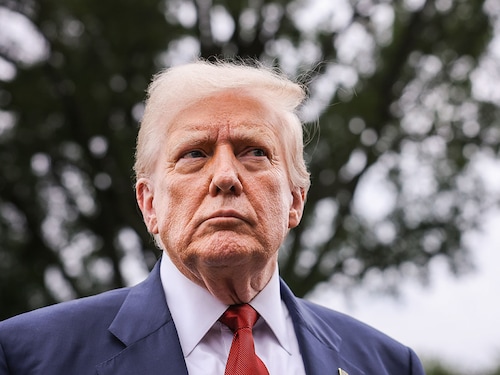Why the tariff tantrum? Trump is desperate for a trade deal with India
The US president's threats of 50 percent tariffs show how badly he wants in on a market that will soon expand its GDP by the size of a Norway or Singapore every year


US president Donald Trump can’t seem to get India out of his mind. He slapped on an additional 25 percent tariff on India on Wednesday, effectively doubling tariffs to 50 percent on most imports from India.
The ostensible reason: India’s intransigence over its oil purchases from Russia. India doesn’t “care how many people in Ukraine are being killed by the Russian War Machine", Trump had said on his micro-blogging platform, Truth Social, on Monday.
India has said its Russian oil imports are in its national interests. “We have already made clear our position on these issues, including the fact that our imports are based on market factors and done with the overall objective of ensuring the energy security of 1.4 billion people of India," the Ministry of External Affairs said in a statement.
While much of this is optics amidst inconclusive, months-long trade negotiations between the largest and the fifth-largest economies of the world, the latest Trump tirade merits a look at his recent India obsession.
In short, India is the world’s biggest growth market for the next two to three decades. In just the three years to 2027, India would have added $1 trillion to its GDP—more than Switzerland’s national income today. Thereafter, it is projected to add some $500 billion every year, overtaking Germany and Japan in the process.
Let that sink in: India will soon about add to its heft a Norway- or Singapore-sized GDP every year. Repeat: Every year. Which leader in the modern world will not want a share of that single largest growth market?
Drill down some more: Which are the sectors that will move the needle for the Indian economy and have the US and Trump eager to get a bigger pie of it?
The first is energy, a good fit for the US, the world’s largest oil and gas producer. India’s minister for petroleum and natural gas, Hardeep Puri, a retired officer of the country’s diplomatic corps, has repeatedly made the point that the country will account for one-fourth of the world’s energy demand in the next two decades.
Guess who are the top suppliers currently? Iraq, Saudi Arabia, Russia and the UAE. The US comes a distant fifth in that list, rubbing shoulders with Nigeria.
Despite his apparent disbelief in global warming, Trump will not want to miss out on the renewable energy market in India, ranging from solar cells to wind energy as Prime Minister Narendra Modi’s government doubles down on seizing the country’s natural advantage: A geographical spread that has good sunlight for around 300 days a year which, despite the haze over the country, thanks to its coal-fired plants, can be a game changer as solar-tech improves efficiency in leaps and bounds.
India, except in the last three years of the Russia-Ukraine war, has been the world’s largest importer of defence equipment. The absolute number has been dropping in the country’s atmanirbharta, or self-reliance, drive but with the world’s third largest defence budget, India remains on the radar of the world’s largest defence exporter nations—a ranking led by the US.
Russia, a traditional arms supplier to India, has given up a large share to France in recent years but the US has not been able to make substantial inroads other than transporter aircraft and drone deals. That is something the likes of Lockheed Martin, RTX Corp, Northrop Grumman and Boeing, among others, will want to see changing in the next few decades as India’s relationships with both Pakistan and China get tested.
The other big sector for US companies and brands is India’s consumer market, what with world-beating demand for anything from cooking oils to toilet paper. With the world’s largest population, India offers the single largest aggregated market for MNCs in the world in the next 25 years. Little surprise then that news reports say one of the top asks by the US is access to India’s agriculture and dairy markets.
The game is not just in volumes driven by a large population. There’s a subtle shift towards branded products and organised retail fuelled by a dual-income young demographic, rising financial inclusion and rapid urbanisation. More Indians live in well-serviced cities today than all of the European Union population. Urban Indians will count some 675 million by 2035, projects the United Nations.
Those families aspire to buy Apple’s iPhones in marked-down sales and ACs (a necessity in a tropical market that has brands like Carrier Global charged against Korean rivals) and want to wear Nike shoes on a date at the neighbourhood McDonald’s or Taco Bell—music to Trump’s and US Inc’s ears.
A larger population of people with less spending power (helped by generous welfare spending by governments) needs better infrastructure to lead their lives. Reliable electric power from solar, wind, gas or other sources roads, highways, railroads and airports to ply on and fly through potable water and sewerage that flows. As businesses decouple from China, India will need global-size manufacturing sites, semiconductor fabs, giga factories, etc. All these rings the till for construction and engineering majors as well as big-ticket infrastructure financiers. US majors such as Bechtel to Jacobs Engineering, and BlackRock to CalPERS could win big.
With stronger trade ties, there are the Indian inputs into American efficiency. Information technology and AI-support services, electronic manufacturing as the US moves out of its China orbit, and better integration with India’s pharma prowess to lower the cost of health care delivery in the US are examples that could help Trump end his second term as a president who meant business.
(Josey Puliyenthuruthel is a business writer and editor based in Bengaluru.)
First Published: Aug 07, 2025, 11:59
Subscribe Now